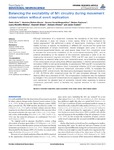Balancing the excitability of M1 circuitry during movement observation without overt replication

Ver/Abrir
Use este enlace para citar
http://hdl.handle.net/2183/14447
Excepto si se señala otra cosa, la licencia del ítem se describe como Creative Commons Attribution 4.0 International License (CC-BY 4.0)
Colecciones
- Investigación (FCS) [1295]
Metadatos
Mostrar el registro completo del ítemTítulo
Balancing the excitability of M1 circuitry during movement observation without overt replicationAutor(es)
Fecha
2014-09-17Cita bibliográfica
Arias P, Robles-García V, Corral-Bergantiños Y, Espìnosa N, Mordillo-Mateos L, Grieve K, Oliviero A, Cudeiro J. Balancing the excitability of M1 circuitry during movement observation without overt replication. Front Behav Neurosci. 2014;8:316
Resumen
[Abstract] Although observation of a movement increases the excitability of the motor system
of the observer, it does not induce a motor replica. What is the mechanism for
replica suppression? We performed a series of experiments, involving a total of 66
healthy humans, to explore the excitability of different M1 circuits and the spinal cord
during observation of simple movements. Several strategies were used. In the first
and second experimental blocks, we used several delay times from movement onset
to evaluate the time-course modulation of the cortico-spinal excitability (CSE), and its
potential dependency on the duration of the movement observed; in order to do this
single pulse transcranial magnetic stimulation (TMS) over M1 was used. In subsequent
experiments, at selected delay times from movement-onset, we probed the excitability
of the cortico-spinal circuits using three different approaches: (i) electric cervicomedullary
stimulation (CMS), to test spinal excitability, (ii) paired-pulse TMS over M1, to evaluate the
cortical inhibitory-excitatory balance (short intracortical inhibition (SICI) and intracortical
facilitation (ICF)], and (iii) continuous theta-burst stimulation (cTBS), to modulate the
excitability of M1 cortical circuits. We observed a stereotyped response in the modulation
of CSE. At 500 ms after movement-onset the ICF was increased; although the most
clear-cut effect was a decrease of CSE. The compensatory mechanism was not explained
by changes in SICI, but by M1-intracortical circuits targeted by cTBS. Meanwhile, the spinal
cord maintained the elevated level of excitability induced when expecting to observe
movements, potentially useful to facilitate any required response to the movement
observed.
Palabras clave
Movement observation
Replica cancelation
Motor cortex
Human
Mirror Neuron system
Replica cancelation
Motor cortex
Human
Mirror Neuron system
Versión del editor
Derechos
Creative Commons Attribution 4.0 International License (CC-BY 4.0)






